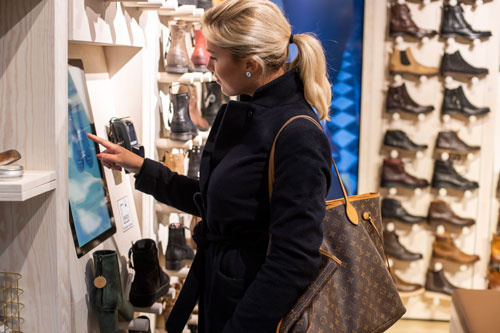August 21, 2019
How in-store touchscreen self-service kiosks boost salesHow in-store touchscreen self-service kiosks boost sales

Happy customers are the beating heart of every business. More than ever, retailers are looking for solutions that provide an experience that delights customers and ensures they keep coming back. Solutions that allow the frictionless service customers expect: on their terms and without delay. That’s why in-store touchscreen self-service kiosks are such an important game-changer.
A self-service kiosk is basically a screen device in the store that supports customers without assistance from sales staff. Handy touchscreens can display information and carry out actions. Flexible solutions that come in all sizes and formats, touchscreens feature technology that is easy to use. Touching icons comes intuitively even to customers who are not used to computers. Moreover, touchscreen technology can easily evolve with customer needs. Self-service kiosks are therefore ideal to put in strategic places, or to bring new life to an underutilized store area.
Customers value the convenience and efficiency of touchscreen self-service kiosks. In its Global State of Multichannel Customer Service Report, Microsoft surveyed over 4,000 consumers. No fewer than 40% stated they expect companies to have a self-service offering.
Skipping the salesperson
Who’s driving this change in customer expectations? Millennials. Making up 2.5 billion of global population, this generation is expected to spend $1.3 trillion by 2020. Unlike their parents, who see human interaction as necessary for excellent service, millennials prefer fast, technology-based solutions. According to a report by EY*, this cohort wants information at their fingertips, are self-reliant and don’t feel the need to talk to in-store experts.
How exactly do touchscreen self-service kiosks meet these expectations for a consistent and seamless customer experience – and ultimately generate more revenue?
Cutting wait times with touchscreen self-service kiosks
Research shows that 45% of customers abandon concession lines due to wait times. This not only means losing a sales opportunity, but potentially the customer’s business entirely. If a brand or store doesn’t meet customer expectations, they are easily persuaded to become loyal to one that does.
However, with touchscreen self-service kiosks wait times can be reduced up to seven seconds according to a Harvard Business Review Study. Think about self-checkouts that let customers check out and pay themselves. They improve the shopping experience by giving customers the control they desire.
Enhancing your brand and service
Research shows that 45% of customers abandon concession lines due to wait times. This not only means losing a sales opportunity, but potentially the customer’s business entirely. If a brand or store doesn’t meet customer expectations, they are easily persuaded to become loyal to one that does.
Touchscreens can also add to the brand experience by giving customers the opportunity to personalize anything from the pattern of their new sneakers to the name of their favorite accessory. They help build brand affinity as well, for example by displaying customer information such as, Our clothes are ethically and sustainably made
.
In addition, these kiosks not only speed up transactions, reduce lines and cut waiting times. They also free up staff to deliver enhanced service. More people served faster equals greater profits.
Wait-warping
Touchscreen self-service kiosks have an important psychological benefit for customers as well. Due to a phenomenon called wait-warping
, customers feel more actively involved, making time fly. The whole checkout process seems faster even if it’s not.
Triggering customers to spend more
Self-service kiosks inspire customers to buy more. There are several factors to this. First, the practical side: a kiosk never forgets to upsell. Programmed to upsell and cross-sell without error, touchscreen kiosks don’t come across as pushy. Think about a customer looking for a new skirt and browsing the catalogue at the store’s information kiosk. She immediately gets suggestions about a matching pair of shoes, extra color options, availability and delivery methods.
Second, they change customer behavior. They lower inhibitions and encourage customers to go for what they truly desire. In front of a salesperson a customer may be reluctant to buy that second pair of shoes – the same but with a slightly different color. With a touchscreen kiosk offering to deliver both pairs directly to the customer’s doorstep, there’s no reason to hold back.
Bringing the online shop in-store
Touchscreen self-service kiosks can be seamlessly connected with the store’s other sales touchpoints. They can, for example, merge the online shop with the physical store. A customer can perfectly reserve a clothing item online, try it on at the store, and complete the online order with the store’s click & collect kiosk. A 2016 BRP study of multi-channel shoppers showed that compared to single-channel customers, they spent an average of 4% more on every shopping occasion in the store and 10% more online.
Touchscreen self-service kiosks are flexible solutions, offering multiple features and functions to create a seamless customer experience. They’re a strategic investment that boosts sales, helps employees better advise customers, and centralizes all products and orders. With their captivating touchscreens, self-service kiosks create high-impact experiences that delight customers and provide the building blocks for future retail success.
*One tough customer: How Gen Z is challenging the competitive landscape and redefining omnichannel, EY (formerly Ernst & Young)